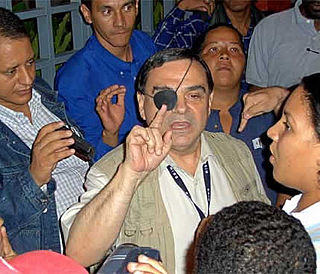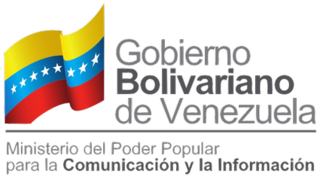Mass media in Venezuela comprise the mass and niche news and information communications infrastructure of Venezuela. Thus, the media of Venezuela consist of several different types of communications media: television, radio, newspapers, magazines, cinema, and Internet-based news outlets and websites. Venezuela also has a strong music industry and arts scene.

Venevisión is a Venezuelan free-to-air television channel and one of Venezuela's largest television networks, owned by the Cisneros Media division of Grupo Cisneros.

Miranda State is one of the 23 states of Venezuela and the second most populous after Zulia State. As of the 2011 census, it had a population of 2,675,165 residents. It also has the greatest Human Development Index in Venezuela, according to the Venezuelan National Institute of Statistics. The most recent population estimate was 3,194,390 in mid-2016.

Telesur is a Latin American terrestrial and satellite news television network headquartered in Caracas, Venezuela and sponsored by the governments of Venezuela, Bolivia, Cuba and Nicaragua. It was launched in 2005, under the government of Hugo Chávez, promoted as "a Latin socialist answer to CNN". In Latin America, teleSUR can be seen in Argentina, Colombia, Chile, Ecuador, Peru, Uruguay and other territories as Aruba, Trinidad and Tobago, Barbados and Curaçao in DirecTV's package.

Walter Nelson Martínez Martínez is a Venezuelan award-winning journalist, originally from Uruguay. Martínez's career spans over three decades in radio, television and the press. He is best known for his work in international relations, and also for using a patch in his right eye, due to a home plumbing accident.

Corporación Venezolana de Televisión or VTV is a state-run television station based in Caracas, Venezuela, which can be seen throughout the capital and surrounding areas on channel 8. Programs that can be seen on VTV included Aló Presidente and Telesur Noticias.

Radio Caracas Televisión (RCTV) was a Venezuelan free-to-air television network headquartered in the Caracas neighborhood of Quinta Crespo. It was sometimes referred to as the Canal de Bárcenas. Owned by Empresas 1BC, Radio Caracas Televisión (RCTV) was inaugurated on 15 November 1953 by William H. Phelps, Jr. Its radio counterpart was Radio Caracas Radio.

Canal Maximo Televisión (CMT) was a Venezuelan free-to-air television network that was seen on UHF channel 51 in the metropolitan area of Caracas, Barquisimeto, and the Miranda State, channel 43 in Calabozo, Puerto Ordaz, and the Zulia State, and channel 21 in San Cristóbal.

Asamblea Nacional Televisión (ANTV) was the television station of the National Assembly of Venezuela. It was created in 2005 to cover the proceedings of Venezuela's National Assembly. Their goal is to increase the participation of Venezuelan citizens in the legislative debates. The signal is seen by those with a cable or satellite subscription in Venezuela, under the name Fundación Audiovisual Nacional de Televisión, that it's not the current National Assembly channel; therefore, the Assembly broadcasts their sessions in a YouTube channel also called ANTV.
Eladio José Lárez Villamizar is a Venezuelan businessperson and TV Presenter. He is the President of Radio Caracas Televisión (RCTV), which until its removal from the public airwaves on 27 May 2007, was the most watched television channel in Venezuela.

TVES is a Venezuelan public television channel. Its name is short for Televisora Venezolana Social and is pronounced, meaning you see yourself. It replaced the signal of Radio Caracas Televisión on Channel 2 on 28 May 2007, and began broadcasting at 12:20 a.m. local time. The Venezuelan government had refused to renew RCTV's broadcasting license and instead determined to create a new channel from part of RCTV's infrastructure. The new channel, in contrast with RCTV, is public-owned. According to the government, TVes aims to portray the identity of Venezuelans, hence the pronunciation of the station's name meaning you see yourself.

Televisora Nacional was the first television station (state-owned) to begin operations in Venezuela. It broadcast from 1952 to december 31, 1991 making Venezuela the ninth country in the world to have television.
Television in Venezuela began in 1952, when the president Marcos Pérez Jiménez launched the state channel Televisora Nacional, making Venezuela the ninth country in the world to have a public television network. By 1963, a quarter of Venezuelan households had television; a figure rising to 45% by 1969 and 85% by 1982. Telenovelas are popular in Venezuela, and some Venezuelan productions are distributed internationally. Perhaps the best known television show internationally was President Hugo Chávez' weekly talk show Aló Presidente, which began in 1999 and ended in 2012. The government also makes regular use of cadenas.

Aló Presidente was a long-running, unscripted talk show hosted by former Venezuelan President Hugo Chávez. It was broadcast on Venezuelan state television and radio channels, including Venezolana de Televisión, on Sundays from 11:00am until mid/late afternoon. The show was a powerful tool in promoting Chavista socialist ideals of the Bolivarian Revolution to supporters in Venezuela and beyond. Many editions were filmed outdoors before large audiences, commonly featuring a local farm, factory, school, hospital, housing project or other public investment. Although Chávez typically appeared on television several times a week, Aló Presidente was his opportunity to reach most families on their day off.

Radio Nacional de Venezuela is a government radio station in Venezuela. Broadcasting began in 1936. The station is currently run by the Venezuelan governments Ministry of Popular Power for Communication and Information (MINCI).
HispanTV is an Iranian Spanish language news channel operated by Islamic Republic of Iran Broadcasting, Iran's state-controlled broadcaster. It began broadcasting in December 2011.

The Sistema Público de Radiodifusión del Estado Mexicano until 2014, is an independent Mexican government agency. Its mission is to support the development of public broadcasting in the country and expand its coverage. It carries out this goal through ownership of a nationwide network of transmitters and the management of its own public television channel, Canal Catorce. It also owns four radio transmitters.

The Ministry of Popular Power for Communication and Information (Minci) is a public ministry of the Government of Venezuela dedicated to communication, informing the Venezuelan public and promoting the Venezuelan government.
Marta Colomina Reyero is a Spanish-Venezuelan journalist and retired college professor. For two decades she taught journalism in her alma mater, the University of Zulia. During the 1980s she was president of the Venezuelan state television channel, Venezolana de Televisión, and held a column of opinion in the newspaper El Universal for almost twenty years. Since 2014, she has written for the newspaper El Nacional.
Margarita D'Amico was a Venezuelan journalist, researcher, and professor who made a substantial impact on art criticism and cultural journalism in Venezuela.














